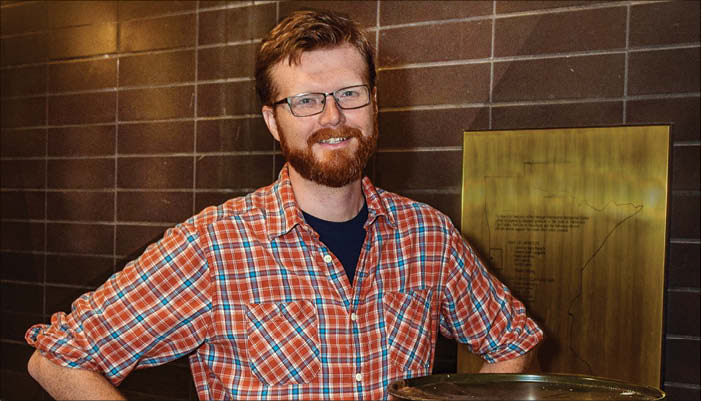Historian Markus Krueger has a fallout shelter in his home in south Moorhead. “My wife says that I’m the only guy who, given the choice of a house with a garage or a fallout shelter in its basement, would pick the shelter,” he confesses.
It’s a handy dose of reality, though, for the program director of the Historical and Cultural Society of Clay County as he prepares for “Atomic Age: Declassified,” a parlor talk Tuesday, Aug. 29. He’ll share the podium at the Hjemkomst Center with Roger Stenerson, who’ll recount his experiences with the aboveground nuclear tests of the early 1950s – the region’s last man standing who has personally witnessed the atomic bomb.
Markus, who’s pushing 40, is too young to have lived through the planet’s obsession 60 years ago with what seemed the looming shadow of imminent warfare. His post at the historical society, though, opens the doors to the day-to-day fears of his parents’ generation – summed up in that one particular room in his basement, built of corrugated metal encased in a foot of concrete.
“Was Fargo-Moorhead actually a target for Russian bombers?” the historian asks. The answer: It depends.
“No, not before 1949,” he says. “Until then, we were the only ones who had the bomb. But then the Russians developed their own.” As the weapons proliferated on both, the possibility of widespread attack increased: “They had enough bombs to go around.”
By 1954, the equation had swung toward a definite “yes.” “If they were headed for Washington, D.C., Soviet bombers would approach from Siberia over the North Pole,” Markus says. “North Dakota and Minnesota wereon the front lines.”
The Happy Hooligans of the North Dakota Air National Guard were tasked with defending against them. Flying F-94 Starfire jet fighters, the unit was equipped with 1.5-kiloton nuclear rockets. Their strategy: To blast an entire squadron of incoming bombers right out of the sky over Manitoba. The Minnesota Civil Defense Department declared Fargo-Moorhead a principal target in 1957, due to their base at Hector Airport a prime target.
As tensions heightened, civil defense plans evolved. The first, for likely targets, was to get everyone out of town. Evacuation routes were laid out to hurry residents to what was deemed a safe distance away – 50 miles. The Clay County civil defense directors, Sheriff Parker Erickson, posted signs at roads leading from Moorhead. Northside residents were to head to Ada on Highway 75. Central Moorhead would take Highway 10 to Detroit Lakes, and the south part of the city would head to Breckenridge or Fergus Falls. Some of the round evacuation route markers would remain along roads into the 1980s. President Eisenhower initiated the interstate highway system in part to facilitate easy escape from the cities likely to be targeted.
Meanwhile, though – Markus says – the thinking on survival changed. Home fallout shelters came into vogue in 1961 as the Cold War heated up. No records were kept of how many homeowners installed them at a cost he estimates at the equivalent of $20,000 in today’s dollars. “People didn’t talk about them much,” he points out. “No one had room or supplies for all the neighbors.”
The next year, though, the national focus shifted to public shelters. In Moorhead, the old high school (now the Townsite Center) was one of the most prominent; a small yellow-and-black sign near the north entrance still marks its role. Others were set up in the public library, churches, campus buildings and even the Comstock Hotel.
“The fallout shelter craze trailed off in the era of ‘mutually assured destruction,’” the historian observes. The electrifying one-two punch of the Cuban missile crisis and scientists’ predictions of the worldwide nuclear winter that would follow atomic destruction sobered the two superpowers. It didn’t deter them; instead, it was understood that the thousands of weapons stockpiled by both sides insured that whoever pushed the button first would be the second to die. It was the era of “Dr. Strangelove,” “On the Beach” and “Failsafe.”
Grand Forks and Minot Air Force Bases, established in 1954 and 1958, had drawn an ever-larger bull’s eye around the Upper Midwest. B-52s on practice flights roared over western North Dakota, and the Minuteman Inter-Continental Ballistic Missile System seeded the prairie with missile silos. Anti-ballistic missiles followed. “I remember my father, who’d been an army chaplain, telling me that if North Dakota seceded, it would be the third biggest nuclear power on earth,” Markus reflects. “We were living in Finley at the time, right in the middle. He’d also say we wouldn’t have to worry about surviving the fallout: ‘If the bombs drop, we won’t feel a thing.’”
He’ll draw from the historical society’s collection of artifacts for his presentation – from barrels that stockpiled water (and then could be used as commodes) to photographs, maps and civil defense publications, among them “Bert the Turtle Says ‘Duck and Cover.’” He’ll even share photos of his own home shelter – now just another basement bathroom that houses their cats’ litter box.
Like Roger Stenerson, his fellow speaker for “Atomic Age: Declassified,” Markus says the best and, indeed, the only real plan for surviving atomic warfare is the oldest and the simplest: Don’t have a nuclear war. That’s intended to be a calming message in these days, when North Korea’s tests of missiles capable of striking the U.S. have ratcheted up the rhetoric of “fire and fury such as the world has never seen” in Washington, D.C.
“The principle of ‘mutually assured destruction’ has basically kept us safe, at least so far,” he points out. “It depends on each side knowing what the other’s doing, then acting in a logical way, knowing the enormous, horrible price everyone would pay.
“As long as everyone is acting rationally and predictably, we seem to be okay.”
Find more information on the HCSCC’s parlor talk “Atomic Age Declassified” and order tickets to the event – 6 p.m. Aug. 29 at the Hjemkomst — online at eventbrite.com.



